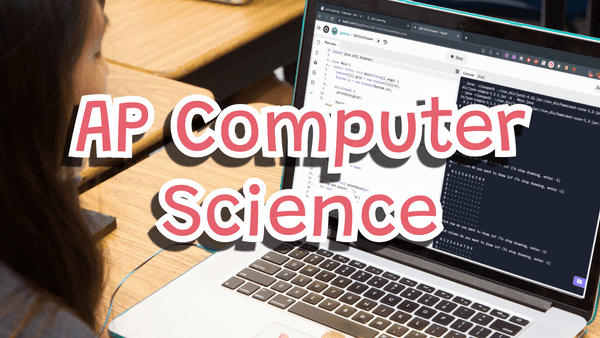AP Computer Science A
Prepare for the AP Computer Science exam with Juni. This course teaches Java fundamentals and is tailored to the exam in May. One-on-one help provides support outside of the classroom. Give them a great shot at college credit with this prep course.

- Private 1:1
- Format
- Age 14-18
- Learners
- Weekly
- Classes
- 50 minutes
- Per class

About this Course
Whether your learner is aiming for a 5, or feeling like they need extra support, Juni’s AP Computer Science course is a great solution. Students are first paired with a personalized 1:1 instructor who has received a 5 on the AP exam. With their guidance, students then work through our custom, exam-focused curriculum.
Billing
Billed as
$275 / month
Scheduling
1:1 classes are 50 minutes long and can be scheduled anytime Monday-Sunday from 7am to 7pm PT. To begin, select Book your Placement Class to signup. Our team will then match you and set up your first class!
- Course duration4-6 months
- Lesson50 minutes
Learning Targets
Variables
Variables-1: I know what a variable is and when to use a variable in my code
Variables-2: I can initialize a variable in Java
Variables-3: I can print out a variable in Java
Variables-4: I know the difference between System.out.print and System.out.println in Java
Variables-5: I know how to use escape characters in Java
Variables-6: I know the difference between primative types and strings
Variables-7: I can get user input in Java
Variables-8: I can use string concatenation correctly in Java
Variables-9: I understand and can use Math.random() correctly in Java
Conditionals
Conditionals-1: I know the difference between == and .equals() and when to use each one in Java
Conditionals-2: I know what a conditional statement is
Conditionals-3: I understand when and how to use 'if' statements in Java
Conditionals-4: I can use '&&' logically to check multiple conditions in Java
Conditionals-5: I can use '||' logically to check multiple conditions in Java
Conditionals-6: I understand when and how to use 'else if' statements in Java
Conditionals-7: I understand when and how to use 'else' statements in Java
Conditionals-8: I can write nested 'if' statements in Java
Loops
Loops-1: I know what a loop is and when to use a loop in my code
Loops-2: I know the difference between a for loop, an enhanced for loop, and a while loop and when to use each in my code
Loops-3: I can write a for loop in Java with a specified starting point, ending point, and increment
Loops-4: I can write a while loop in Java with a specified starting point, ending point, and increment
Loops-5: I can correctly use combinations of loops to produce a desired output in Java
Loops-6: I can write a nested loop in Java
Loops-7: I understand how to find the total amount of times a line of code in one or more loops runs
Exceptions
Exceptions-1: I can explain the difference between checked exception and unchecked exceptions
Exceptions-2: I can identify and fix arithmetic exceptions
Exceptions-3: I can identify and fix null pointer exceptions
Exceptions-4: I can identify and fix syntax errors
Exceptions-5: I understand the importance of semicolons at the end of a line in Java
Classes
Classes-1: I know what objects and classes are and why they are useful in code
Classes-2: I can create a class in Java
Classes-3: I understand the purpose of and can define the instance variables of a class in Java
Classes-4: I understand the purpose of and can define a constructor for a class in Java
Classes-5: I understand and can use the new keyword in Java
Classes-6: I understand the role of a class definition in relation to an instance of that class
Classes-7: I understand privacy modifiers and their affect on my class
Classes-8: I understand and can use the this keyword in Java
Class Methods
Class Methods-1: I can create a method in a class in Java
Class Methods-2: I can call a class method in the main method in Java
Class Methods-3: I know how to define a getter method to access the value of an instance variable in Java
Class Methods-4: I know how to define a setter method to modify the value of an instance variable in Java
Class Methods-5: I understand and can use the static keyword in Java
Class Methods-6: I can set a static variable in the main method in Java
Class Methods-7: I understand the role of static classes
Class Methods-8: I understand the role of method overloading and how to implement it in Java
Inheritance
Inheritance-1: I understand class construction in an inheritance setting in Java
Inheritance-2: I understand and can use the super keyword in Java
Inheritance-3: I can override a method for a subclass in Java
Inheritance-4: I can overload the constructor for a class in Java
Inheritance-5: I can overload a method in a subclass context in Java
Inheritance-6: I understand that subclasses can have their own functionality
Polymorphism
Polymorphism-1: I understand what polymorphism is, and the relationship between subclasses and superclasses
Polymorphism-2: I understand method selection with shared attributes in Java
Polymorphism-3: I understand behavior when a non-existent method is called in Java
Polymorphism-4: I understand static lookup in Java
Polymorphism-5: I understand downcasting in Java
Design
Design-1: I understand the role of a spec in software developement
Design-2: I understand how to translate written spec into a programming plan
Design-3: I can follow a spec and ask questions when unclear
Arrays
Arrays-1: I can use multiple instantiation methods for arrays in Java
Arrays-2: I can set the elements of an array with a loop in Java
Arrays-3: I understand enhanced for loop syntax with arrays in Java
Arrays-4: I understand creation and instantiation of 2D arrays in Java
Arrays-5: I can iterate through a 2D array in Java
Arrays-6: I can identify and fix the ArrayIndexOutOfBounds exception
Arrays-7: I can access and interact with each element in a 2D array in Java
Arrays-8: I understand enhanced for loop syntax with 2D arrays in Java
ArrayLists
ArrayLists-1: I understand what an ArrayList is, and how it is different from an array.
ArrayLists-2: I can use the add(loc, elem) method correctly in Java
ArrayLists-3: I understand what an ArrayList can hold in Java
ArrayLists-4: I can instantiate an ArrayList in Java
ArrayLists-5: I understand how to correctly use .size(), .add(), or .set() with ArrayLists in Java
ArrayLists-6: I can create a 2D ArrayList in Java
ArrayLists-7: I can use the enhanded for loop syntax with ArrayLists in Java
ArrayLists-8: I understand and prevent the concurrent modification error
Wrapper Classes
Wrapper Classes-1: I can explain the role of wrapper classes in Java
Wrapper Classes-2: I can utilize number wrappers in Java
Wrapper Classes-3: I understand autoboxing in Java
Wrapper Classes-4: I can use the .intValue() method correctly in Java
Runtime
Runtime-1: I understand runtime analysis and the motivation behind it
Runtime-2: I can analyze the runtime of nested for loops
Runtime-3: I can analyze the runtime of interdependent nested for loops
Runtime-4: I understand the impact of a return statement on runtime.
Runtime-5: I understand the difference between the best-case and worst-case scenario in the context of runtime
Recursion
Recursion-1: I know what a recursive function is and its two key parts
Recursion-2: I understand infinte recursion, and can identify when it will happen
Recursion-3: I can analyze the runtime of recursive methods
Sorting
Sorting-1: I understand and can explain the process by which the Selection Sort algorithm sorts data
Sorting-2: I understand and can explain the process by which the Insertion Sort algorithm sorts data
Sorting-3: I understand and can explain the process by which the Merge Sort algorithm sorts data
Sorting-4: I can analyze the runtime of a given sorting algorithm, taking into account best and worst cases
Searching
Searching-1: I understand the difference between Sequential Search and Binary Search
Searching-2: I understand and can explain the process by which the Binary Search algorithm searches for a piece of data
Computer Science Habits
I use spacing and logical variable names to improve my code's readability
I regularly comment my code to improve my code's readability
I appropriately and frequently test my code
I can independently debug my code
I can independently determine which classes and objects best meet the goals of a project
General Learning Habits
Joyful Collaboration
- I practice listening to my instructor and sharing my ideas to co-create understanding.
- I attempt tasks independently and ask my instructor questions when I need help.
Unlimited Curiosity
- I take ownership of my learning by asking meaningful questions both when I need clarification and when I want to know more about a topic.
Nimble Determination
- I practice resilience when I am frustrated that I have not yet achieved mastery of a new concept or skill; instead of complaining about challenges, I try new approaches and creative solutions.
Invest in Excellence
- I arrive to class on time and prepared to learn, with my computer set up with a strong internet connection.
- I complete my homework on time, and if I cannot complete my homework due to other obligations, I honestly communicate the reasons for late homework to my instructor.
- I do my best to stay present and on task for the whole session. I support my focus by putting away any distracting technology and setting notifications on my device to “do not disturb” mode.
Homework
Instructors will assign students roughly 60 minutes of project related homework at the end of each session. Homework is designed to complement the class experience and ensure the student continues to gain practical experience outside of the session.
Pre-Requisites
Completion of Python Level 2 or Java Level 2
Students who enter the course having completed Java Level 2 will be able to move through the course at an accelerated pace).

Whether your learner is aiming for a 5, or feeling like they need extra support, Juni’s AP Computer Science course is a great solution. Students are first paired with a personalized 1:1 instructor who has received a 5 on the AP exam. With their guidance, students then work through our custom, exam-focused curriculum.
Who are Juni’s Instructors?
Our instructors are subject matter experts from top US universities. Instructors are highly-vetted and background checked prior to joining and undergo extensive training before ever teaching on our platform.
Upon signing up, parents are asked a series of questions that allow us to match your child with an optimal instructor based on their unique needs and interests. Factors that are considered in our matching process include Learning Style, Personality, Personal Experience, and Academic & Career Aspiration.





